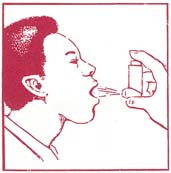
Courtesy of the National Institute of Health, Publication
No. 92-2737
|
Asthma is the most common chronic illness of children in the United States. In recent years, both the prevalence and severity of asthma have increased. Some experts estimate that between 1981 and 1988 asthma in children increased by almost 40% (JAMA, November 18, 1992). In addition, the death rate for children diagnosed with asthma is greater now than 20 years ago (JAMA, October 3, 1990).
Some specialists in the field main.tain that medications used to treat asthma are contributing to this trend. Although Beta2-agonists (bronchodilators) are the most widely prescribed asthma drugs in the United States, a recent New England Journal of Medicine editorial (February 7, 1991) mentions Beta2-agonists as one of the medicines most often associated with fatal or near fatal episodes.
When the editorial first appeared, many patients becaine frightened to use their inhalers. "We received probably 1,500 calls in two weeks," said Nancy Sander of Fairfax, VA, President of the Allergy and Asthma Network. "People were afraid their drugs were killing them and they wanted to take themselves off the drugs. We tried to convince them all to talk to their doctors first" (The N Y Times Magazine, March 28, 1993).
Dr. Benjamin Burrows and Dr. Michael D. Lebowitz of the University of Arizona Health Science Center believe that Beta2-agonists "remain our most effective treatment for acute asthma attacks and are essential for improving the well-being of most patients with asthma. If patients become fearful of using these drugs, those with readily reversible attacks would crowd emergency rooms, where they would immediately receive inhaled Beta2-agonists therapy that they could have taken on their own much sooner" (New England Journal of Medicine, February 20, 1992).
Beta2-agonists administered by a metered dose inhaler help to relieve patients' symptoms. The medication helps to open up the airway (relaxes and dilates the smooth muscle of the bronchi and bronchioles) and inhibits release of mediators from mast cells. This reduces obstruction of the airway that causes asthma symptoms.
Dr. Albert L. Sheffer of Harvard Medical School notes that "overuse of Beta2-agonists could be masking the severity of the asthma." Moreover, the International Consensus Report on Diagnosis and Management of Asthma (National Heart, Lung and Blood Institute, June 1992, Publication No. 92-3091), states "that the patient who is using Beta2-agonists more than one to two times a week to relieve symptoms or has a peak flow measurement lower than 80 percent of personal best, has an asthma problem that has worsened or is not well controlled." This patient may be a candidate for an anti-inflammatory medication to help manage the disease, e.g., Gorticosteroid, cromolyn or ned tative drugs block or reduce swelling of the bronchi, inhibit mucus production, and help to prevent future asthma attacks.
The use of Beta_-agonists to relieve asthmatic symptoms, as just discussed, should not be confused with the prescription of Beta2-agonists as the first line of defense (i.e., to prevent attacks) for the most common trigger of asthma--exercise. Two inhalations of a Bet_-agonists taken approximately 15 min before exercise can be administered on a daily basis to prevent exercise-induced asthma (EIA). Effect of Beta2-agonists will last four hours in two thirds of patients and six hours in the remaining patients (Ventolin, Product Information, 4036847).
If asthma symptoms occur with exercise despite pretreatment with albuterol (a Beta2-agonist sold under such brand names as Ventolin and Proventil), the patient may need an anti-inflammatory medication to manage the asthma. Combined use of anti-inflammatory and bronchodilator drugs help to manage most EIA. Simply put, children with EIA do not have to sit on the sidelines-they can lead active lives, including cardiovascular sport activities when they are properly medicated.
Surprisingly, many professionals involved in physical education and athletics for individuals with disabilities know very little about the effect of prescribed medication for the asthmatic. Has your program acquired a publication such as Teach Your Patients About Asthma: A Clinician's Guide. This is a most valuable resource (National Heart, Lung and Blood Institute, October 1992, No. 92-2737). If you are involved with this population, are you aware that as a professional you need to know the pharmacologic therapy prescribed for each person, how to read and interpret a peak flow meter, and have a written asthma action plan in order to take the necessary steps during an asthmatic episode.